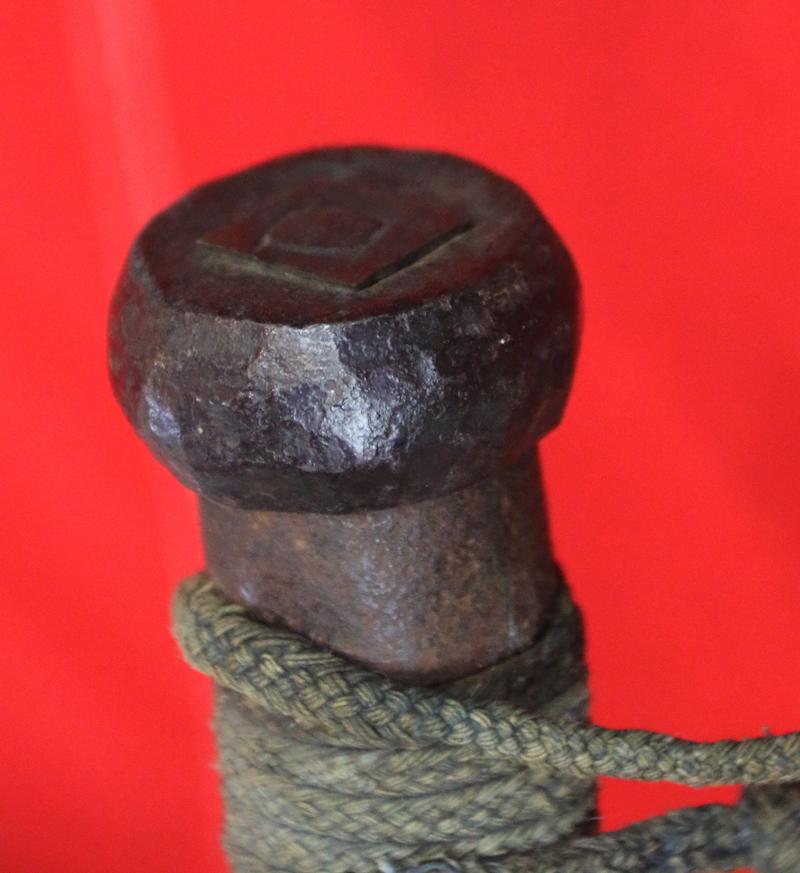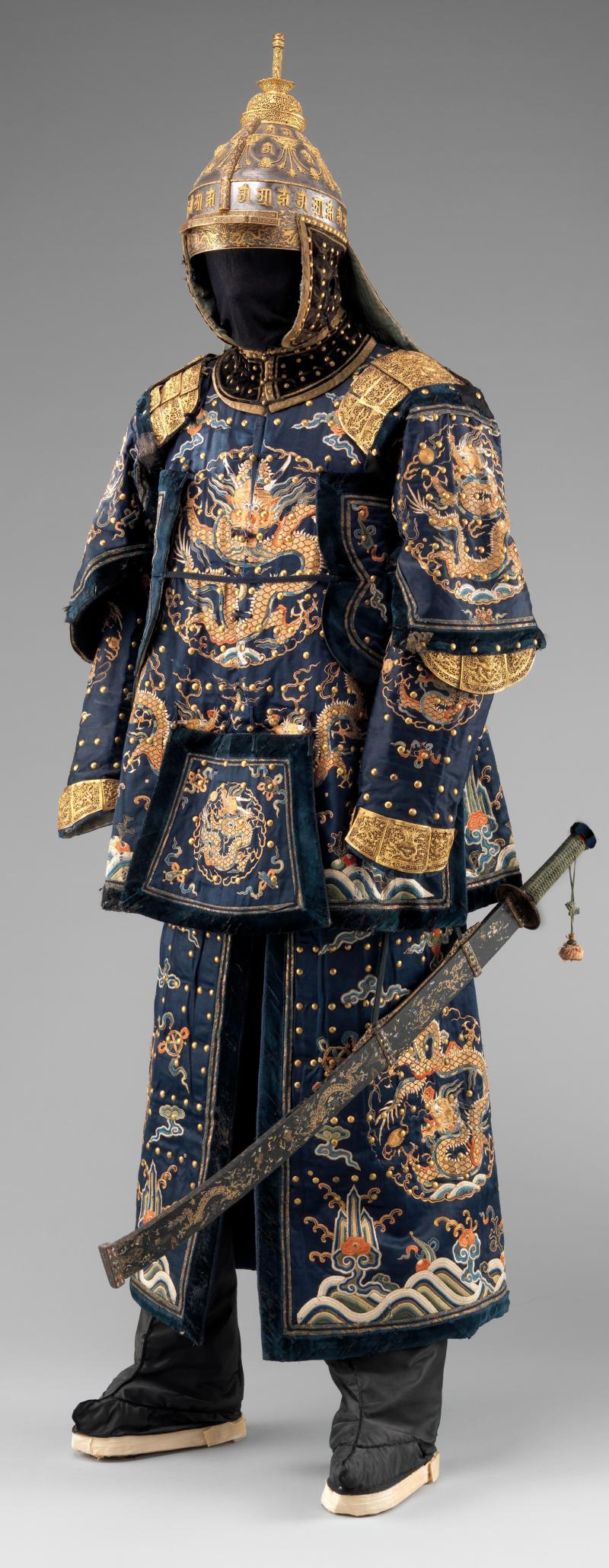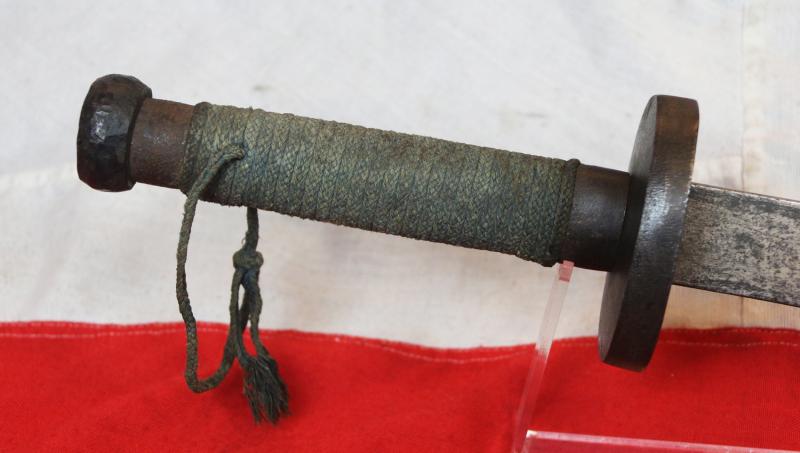A Fabulous & Huge Antique Chinese Ching Dynasty Dao, a Sword of War. A Combat Sword of Immense Stature. From The 1800's During The Imperial Qianlong, Emperor of the Qing, the Manchu Dynasty
Just returned from the conservation team after the blade has been stunningly hand polished and conserved. It now looks incredible
Large traditional plaited blue cord bound hilt with iron,m circular, disc and rimmed crossguard, and a hammered cushion shaped pommel, long single edged blade, that appears curved but is mostly straight but with a curved and expanded tip end. single fuller, likely late Qianlong {aka Chien-lung period}, used until the Boxer Rebellion. Most likely brought back to England by a British soldier that either served in the Opium War, or defended the legations at the siege in Peking.
The Qing dynasty (English pronunciation; Ching), officially the Great Qing, was a Manchu-led imperial dynasty of China (1636–1912) and the last imperial dynasty in Chinese history.
It emerged from the Later Jin dynasty founded by the Jianzhou Jurchens, a Tungusic-speaking ethnic group who unified other Jurchen tribes to form a new "Manchu" ethnic identity. The dynasty was officially proclaimed in 1636 in Manchuria (modern-day Northeast China and Russian Manchuria). It seized control of Beijing in 1644, then later expanded its rule over the whole of China proper and Taiwan, and finally expanded into Inner Asia. The dynasty lasted until 1912 when it was overthrown in the Xinhai Revolution. In Chinese historiography, the Qing dynasty was preceded by the Ming dynasty and succeeded by the Republic of China. The multiethnic Qing dynasty lasted for almost three centuries and assembled the territorial base for modern China. It was the largest imperial dynasty in the history of China and in 1790 the fourth-largest empire in world history in terms of territorial size. With 419,264,000 citizens in 1907, it was the most populous country in the world at the time.
The height of Qing glory and power was reached in the reign of the Qianlong Emperor (1735–1796). He led Ten Great Campaigns that extended Qing control into Inner Asia and personally supervised Confucian cultural projects. After his death, the dynasty faced foreign intrusion, internal revolts, population growth, economic disruption, official corruption, and the reluctance of Confucian elites to change their mindsets. With peace and prosperity, the population rose to some 400 million, but taxes and government revenues were fixed at a low rate, soon leading to fiscal crisis. Following China's defeat in the Opium Wars, Western colonial powers forced the Qing government to sign "unequal treaties", granting them trading privileges, extraterritoriality and treaty ports under their control. The Taiping Rebellion (1850–1864) and the Dungan Revolt (1862–1877) in Central Asia led to the deaths of over 20 million people, from famine, disease, and war. The Tongzhi Restoration in the 1860s brought vigorous reforms and the introduction of foreign military technology in the Self-Strengthening Movement. Defeat in the First Sino-Japanese War in 1895 led to loss of suzerainty over Korea and cession of Taiwan to Japan. The ambitious Hundred Days' Reform of 1898 proposed fundamental change, but the Empress Dowager Cixi (1835–1908), who had been the dominant voice in the national government for more than three decades, turned it back in a coup. Pictured in the gallery from the Metropolitan Museum, a Chinese noble or princes suit of armour of steel and gold and covered with a fabulous woven silk robe decorated with imperial dragons, with, at his waist, the very same form of sword of war, bound with the same green hilt cord, but, with a highly decorated scabbard as befitting a prince.
Every single item from The Lanes Armoury, Britain's famous, favourite, and oldest original Armoury Antique store, is accompanied by our unique Certificate of Authenticity. Part of our continued dedication to maintain the standards forged by us over the past 100 years of our family’s trading, and thus, it is a lifetime guarantee.
No scabbard 42.15 inches long overall, blade 34 inches.
Code: 24869
1750.00 GBP







